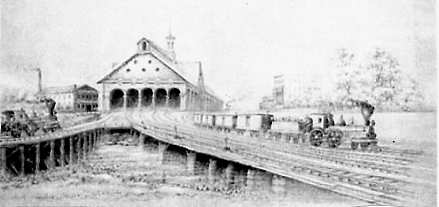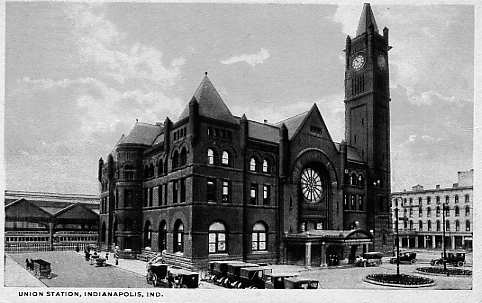
Union Stations Across the U.S.
By Beryl Frank
Indianapolis, Indiana
On October 1, 1847, the first train pulled into Indianapolis over new tracks which came from Madison, Indiana. This was the beginning of Indianapolis becoming one of our country's rail centers. There was need to get growing numbers of trains in and out of town.
Two years later, the Union Railway Company was formed. Tracks were laid which all railroads could use. The birth of the first Union Station was September 28, 1853. It was a brick structure with a train barn, waiting rooms and five tracks.
The station was already too small at the time of the Civil War. The building was widened 200 feet and an eating house was added. By 1886, the original station was demolished.
The city of Indianapolis then hired Thomas Rodd of Pittsburgh to design a new station on the site of the original.
Many consider the building a fine example, if not one of the best examples, of Romanesque Revival architecture in the United States. During the peak of the railroad era, as many as 200 trains moved through this station daily.
By 1970, all over the country, automobiles and airplanes caused the slowing down of train traffic. In Indianapolis, only one ticket window was left. To quote Janet Greenstein Potter, "snow was falling not simply on the roof, but through it."
A Save-Union-Station group was formed, and because of their work the city purchased what was left of the depot. The exterior looks much as it did in 1886. The clock tower is still there. So are the rose windows. The 100-foot-long stained glass skylight, which had been covered since World War II, was uncovered.
A large hotel took part of the space and Pullman cars were parked on the tracks to provide additional hotel accommodations.
This Union Station, on the site of the first Union Station in the country, is very much in use in the 21st century. It was placed on the National Register of Historic Places in 1974.

Sketch of Union Station with steam trains. [Courtesy of Indiana Historical Society]

Sketch of Old Union Station c-1853. [Courtesy of Indiana Historical Society]

When early automobiles were replacing the horse and buggy, the Union Station had a covered entrance for cars delivering passengers. Note the barber pole on the sidewalk on the left side of the building, c-1910.
.